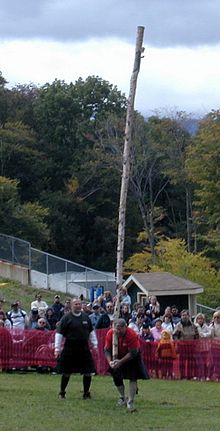
Back Llançament de tronc Catalan Hod kládou Czech Baumstammwerfen German Lanzamiento de cáber Spanish Palgiheitmine Estonian Enbor-jaurtiketa Basque Tukinheitto Finnish Caber French Cabar Irish Cabar Scots/Gaelic
This article needs additional citations for verification. (February 2011) |
 A caber being tossed at the 2000 New Hampshire Highland Games | |
| Presence | |
|---|---|
| Country or region | Scotland |
| Olympic | No |
The caber toss (Scottish Gaelic: tilgeil a' chabair) is a traditional Scottish athletic event in which competitors toss a large tapered pole called a "caber" (/ˈkeɪbər/). It is normally practised at the Scottish Highland Games. In Scotland, the caber is usually made from a larch tree, and it can be between 16–20 feet (5–6 metres) tall and weigh 90–150 pounds (40–70 kilograms).[1][2] The term "caber" derives from the Gaelic word cabar, which refers to a wooden beam.[1]
The person tossing the caber is called a "tosser" or a "thrower".[3]
Although the sport is primarily associated with Scotland, a similar exercise, "casting the bar", was popular in England in the 16th century,[3] and similar sports exist around the world, such as stångstörtning in Sweden.[4]
The record for most caber tosses in three minutes is currently held by Scottish teenager Andrew Murphie. He managed to perform 26 successful caber tosses on 23 June 2024 in Grantown on Spey, Scotland smashing the previous record of 16, which was set in Canada. Each caber was more than 5m (16ft) long and weighed more than 40kg (88lbs), and they had to be flipped over end to end.
The Braemar Caber is the worlds most famous Caber being 19ft 6 inches long and 132lbs in weight and has been won the most times by Alistair Gunn of Halkirk who has won it 8 times, the 8th time in 2007.
- ^ a b Donaldson, Emily Anne (20 January 2001). Scottish Highland Games in America (New ed.). Pelican Publishing Company. pp. 78–79. ISBN 9781455611713.
- ^ Wilkins, Sally (2002). Sports and games of medieval cultures. Westport, Conn.: Greenwood Press. p. 138. ISBN 9780313360794.
- ^ a b Chisholm, Hugh, ed. (1911). . Encyclopædia Britannica. Vol. 4 (11th ed.). Cambridge University Press. p. 917.
- ^ Gimlekultur (20 April 2019). "Stångstörtning". Kulturföreningen Gimle (in Swedish). Retrieved 3 February 2023.